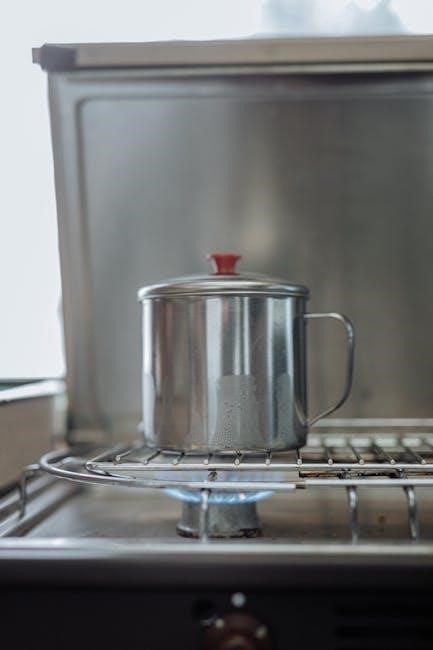Gas heater troubleshooting is essential for ensuring efficient and safe operation. This guide covers common issues‚ diagnostic steps‚ and maintenance tips to help you resolve problems effectively.
1.1 Importance of Regular Maintenance
Regular maintenance is crucial for ensuring your gas heater operates safely and efficiently. It helps prevent issues like carbon monoxide leaks‚ which can pose serious health risks. By inspecting and cleaning components such as filters and burners‚ you can avoid costly repairs and extend the heater’s lifespan. Additionally‚ maintenance ensures optimal performance‚ reducing energy bills and environmental impact. Routine checks also allow early detection of potential problems‚ preventing sudden breakdowns during cold weather. Always prioritize safety checks and consider annual professional servicing to maintain reliability and peace of mind.
1.2 Safety Precautions Before Troubleshooting
Before troubleshooting your gas heater‚ ensure your safety. Always turn off the gas supply and electrical power to the unit. Open windows for ventilation to prevent gas buildup. Never attempt repairs near open flames or sparks. Wear protective gloves and eyewear. If you suspect a gas leak‚ evacuate the area immediately and contact emergency services. Carbon monoxide detectors should be functioning to alert you of potential hazards. Avoid DIY repairs if unsure‚ as improper handling can lead to dangerous situations. Always follow manufacturer guidelines and consider consulting a professional for complex issues.
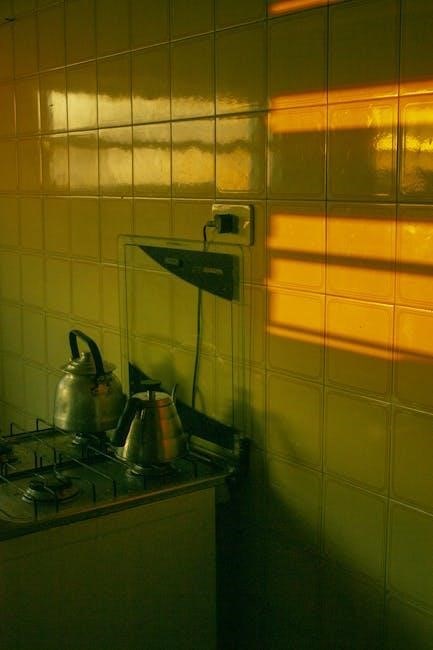
Common Issues with Gas Heaters
Gas heaters often face issues such as pilot light problems‚ burner malfunctions‚ carbon monoxide leaks‚ and venting issues. Regular maintenance is key to preventing these faults and ensuring safe‚ efficient operation.
2.1 Pilot Light Problems
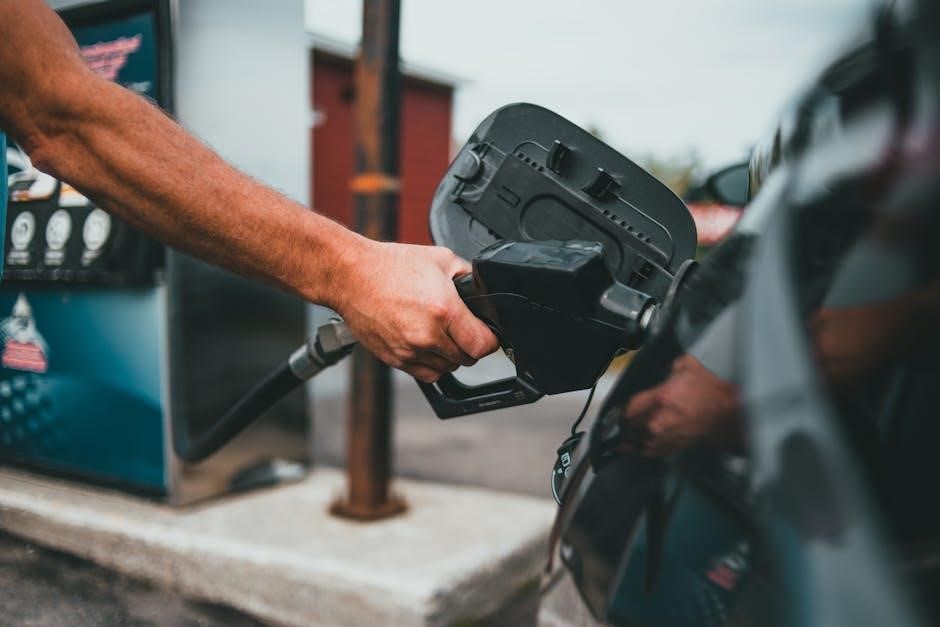
Pilot light issues are common in gas heaters. A faulty pilot light may fail to ignite or stay lit‚ causing the heater to malfunction. This could be due to a dirty or clogged pilot orifice‚ improper gas flow‚ or a malfunctioning thermocouple. If the pilot light is out‚ check for drafts or blockages. Ensure the gas supply is turned on and the pilot orifice is clean. Relighting the pilot may resolve the issue‚ but if problems persist‚ professional assistance is recommended to avoid safety hazards and ensure proper operation.
2.2 Issues with the Burner Not Lighting
If the burner fails to light‚ it could indicate issues with the ignition system‚ gas supply‚ or burner components. Check for obstructions in the burner ports and ensure the gas valve is fully open. A dirty or faulty flame sensor may also prevent ignition. Additionally‚ low gas pressure or a malfunctioning igniter could be the cause. Consult your user manual for specific troubleshooting steps‚ and consider professional help if the problem persists. Always ensure safety by turning off the gas supply before attempting repairs.
2.3 Carbon Monoxide Leaks
Carbon monoxide leaks from gas heaters can pose serious health risks‚ including headaches‚ dizziness‚ and even life-threatening conditions. Cracks in the heat exchanger or improper ventilation are common causes. If you notice flu-like symptoms that worsen when the heater is on‚ suspect a CO leak. Install carbon monoxide detectors and ensure proper ventilation. If a leak is suspected‚ turn off the heater‚ open windows‚ and evacuate the area. Never attempt repairs yourself; contact a certified technician immediately to inspect and fix the issue. Regular maintenance can help prevent such dangerous situations.
2.4 Thermostat Malfunction
A malfunctioning thermostat can disrupt your gas heater’s performance‚ causing inconsistent heating or complete shutdown. Symptoms include the heater not turning on‚ frequent cycling‚ or failure to maintain the set temperature. Check if the thermostat is correctly set and ensure it’s not faulty. Test by adjusting the temperature settings to see if the heater responds. If issues persist‚ inspect wiring connections or replace the thermostat if necessary. A malfunctioning thermostat can also indicate deeper system problems‚ so professional inspection may be required to restore proper functionality and ensure reliable heating.
2.5 Gas Pressure Issues
Gas pressure issues can significantly affect your heater’s performance‚ leading to weak flames‚ inconsistent heating‚ or complete shutdown. If the gas supply was recently turned off and back on‚ the heater might not restart properly. Symptoms include low heat output‚ flickering flames‚ or the heater failing to ignite. Check if the gas valve is fully open and ensure there are no blockages in the gas line. Incorrect pressure settings in the regulator can also cause problems. If you suspect a gas pressure issue‚ contact a professional to adjust the settings safely‚ as improper handling can lead to dangerous situations.
2.6 Venting Problems
Venting issues can lead to reduced heater efficiency‚ safety hazards‚ and even complete system shutdown. Blockages in vents or flues prevent proper gas and combustion byproduct expulsion. Symptoms include reduced heating performance‚ unusual odors‚ or the heater frequently shutting off. Check for debris‚ nests‚ or damage in venting systems. Ensure all vents are clear and properly connected. If issues persist‚ inspect for corrosion or damage and repair or replace faulty components. Proper venting is critical for safe operation‚ so addressing these problems promptly is essential to maintain efficiency and prevent potential safety risks‚ such as carbon monoxide buildup.
2.7 Lack of Heat
A lack of heat from your gas heater can be due to several issues. First‚ check if the pilot light is out or the burner is not igniting. Ensure the gas supply is turned on and the thermostat is set correctly. Dirty filters or blockages in vents can restrict airflow‚ reducing heat output. Additionally‚ a faulty ignition system or malfunctioning gas valve may prevent proper heating. If the issue persists‚ inspect for loose connections or damaged components. Always ensure the system is turned off before performing any internal checks to avoid safety risks. Addressing these problems promptly will restore warmth and efficiency.
2.8 Strange Noises
Strange noises from your gas heater‚ such as rattling‚ clunking‚ or hissing‚ can indicate underlying issues. Rattling sounds may suggest loose components‚ while clunking could point to internal damage or debris. Hissing often signals a gas leak or pressure imbalance. If the noise is persistent‚ turn off the heater and investigate. Check for blockages in vents or burners and ensure all connections are secure. A malfunctioning ignition system or faulty gas valve might also cause unusual sounds. Addressing these issues promptly can prevent further damage and ensure safe operation. Always prioritize safety by turning off the heater before inspecting.
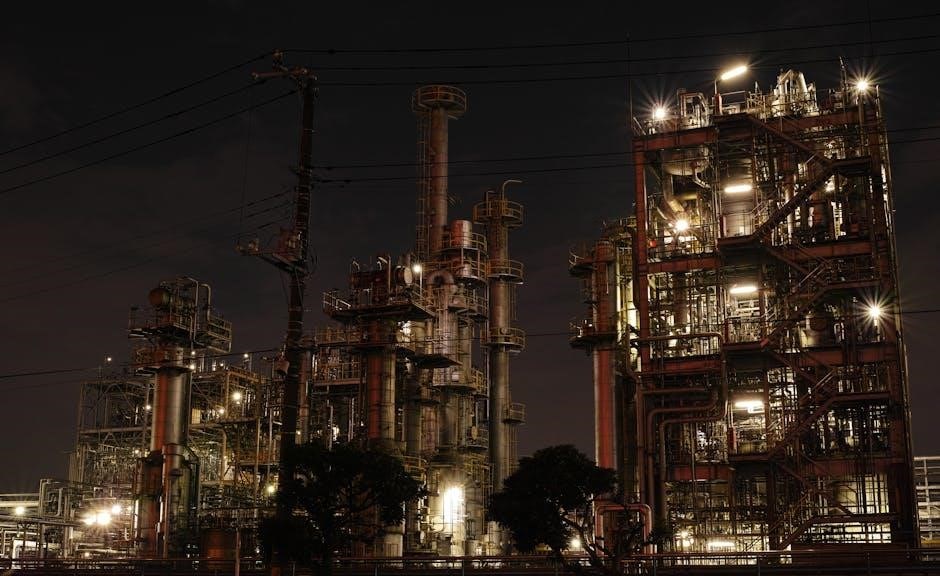
Step-by-Step Troubleshooting Guide

Inspect vents and burners for dust‚ debris‚ or obstructions. Clean or replace filters and ensure proper airflow to maintain efficient and safe gas heater operation.
3.1 Checking the Pilot Light
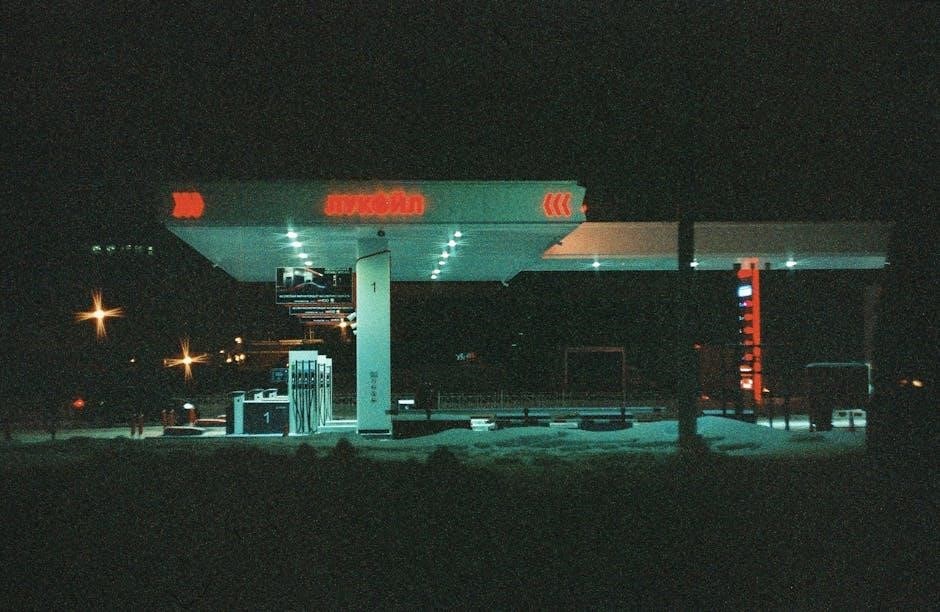
To check the pilot light‚ locate it in your gas heater‚ usually near the burner. Ensure it burns steadily and is blue in color. If the pilot light is out or flickering‚ it may indicate issues like drafts‚ dirt‚ or gas supply problems. Turn off the gas supply and wait before attempting to relight it. Always follow manufacturer guidelines or consult a professional if unsure. A malfunctioning pilot light can prevent the heater from functioning properly and may pose safety risks.
3.2 Relighting the Pilot Light
Relighting the pilot light involves a few simple steps. First‚ ensure the gas supply is on and locate the pilot light access. Press and hold the reset button‚ then use a long lighter or match to ignite the pilot. Hold the reset button for 30 seconds to ensure it stays lit. If the pilot light won’t stay on‚ check for drafts or gas supply issues. Repeat the process if necessary‚ but if it fails repeatedly‚ consult a professional to avoid safety risks like gas leaks or carbon monoxide exposure.
3;3 Inspecting the Burner
Inspecting the burner is crucial for identifying issues. Turn off the heater and allow it to cool. Use a flashlight to check for dirt‚ rust‚ or blockages in the burner ports. Clean the burner with a wire brush or vacuum if necessary. Ensure the burner orifice is clear and free of debris. Look for signs of wear or corrosion that could affect performance. If you notice damage or excessive wear‚ replace the burner promptly. Always ensure proper ventilation and test for carbon monoxide leaks after restarting the heater. If unsure‚ consult a professional to avoid safety risks.
3.4 Testing for Carbon Monoxide
Testing for carbon monoxide leaks is critical for safety. Install carbon monoxide detectors near your gas heater and ensure they are functioning properly. Turn on the heater and observe the detector for alarms. Visually inspect the heater for cracks or corrosion in the heat exchanger‚ which can release carbon monoxide. Use a carbon monoxide test kit or hire a professional to perform precise measurements. If high levels are detected‚ immediately turn off the heater‚ ventilate the area‚ and call a certified technician. Annual inspections by a professional are recommended to prevent potential leaks and ensure safe operation of your gas heater.
3.5 Adjusting the Thermostat
Adjusting the thermostat is crucial for optimal heating. Ensure it’s set to ‘heat’ mode and the desired temperature is higher than the room temperature. For programmable thermostats‚ check the schedule to confirm heating times. If the display is blank‚ replace the batteries. If issues persist‚ consider upgrading to a smart thermostat for better control. Always follow the manufacturer’s instructions for specific models. If adjustments don’t resolve the issue‚ it may indicate a malfunction requiring professional attention. Proper thermostat settings ensure energy efficiency and consistent warmth.
3.6 Checking Gas Pressure
Checking gas pressure is vital for ensuring your heater operates safely and efficiently. Locate the pressure gauge on your gas heater or associated regulator. The ideal pressure varies by model but typically ranges between 3-5 inches of water column for natural gas. If the pressure is too low‚ it may cause the burner to malfunction. Conversely‚ high pressure can lead to dangerous leaks or damage. If you detect irregular readings‚ turn off the heater and consult a professional. Always follow safety guidelines and manufacturer instructions when handling gas systems to avoid potential hazards.
3.7 Inspecting Ventilation
Inspecting ventilation is crucial for safe and efficient gas heater operation. Start by locating the venting system‚ typically found on the roof or exterior walls. Check for blockages such as leaves‚ debris‚ or pests that may obstruct airflow. Ensure all vent pipes are securely connected and free from damage‚ rust‚ or holes. Listen for unusual noises like rattling or hissing‚ which may indicate leaks. Trim nearby plants and inspect after storms to maintain clearance. Use a flashlight and gloves to examine vents‚ and vacuum to remove debris. If damage or severe blockages are found‚ contact a professional to ensure safety and proper function.
3.8 Checking for Blockages
Checking for blockages is vital to ensure proper gas heater function. Start by inspecting the burner ports and heat exchanger for soot‚ rust‚ or debris. Use a soft brush or vacuum to clean obstructions. Check the ignition system for dirt or blockages‚ as this can prevent the burner from lighting. Look for signs of pest infestation‚ such as nests‚ in vents or internal components. Ensure the gas line is free from kinks or restrictions. If you find blockages‚ turn off the gas supply before cleaning. Persistent issues may require professional assistance to avoid safety hazards or further damage.
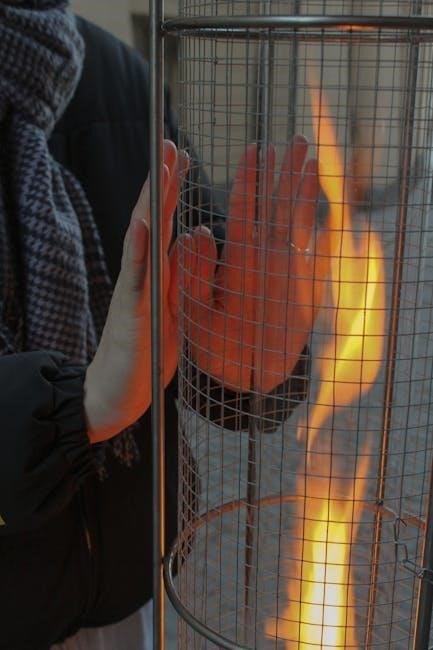
Advanced Troubleshooting Techniques
Advanced troubleshooting involves using specialized tools like multimeters for electrical checks and thermal imaging cameras to detect hidden issues. Inspect internal components such as the heat exchanger and gas valve for damage or malfunctions. Use a manometer to test gas pressure accurately. Check the ignition system for proper function and ensure all sensors are clean and operational. These techniques help identify complex problems that basic troubleshooting might miss‚ ensuring comprehensive diagnostics and effective repairs.
4.1 Using a Multimeter for Electrical Checks
A multimeter is a vital tool for diagnosing electrical issues in gas heaters. It measures voltage‚ current‚ and resistance‚ helping identify faulty wiring or components. Set the multimeter to the appropriate voltage setting and test for power at the thermostat‚ ignition system‚ and safety sensors. Ensure the heater is off before performing any electrical checks. Use the multimeter to verify continuity in circuits and detect short circuits or open connections. Accurate readings can reveal issues like malfunctioning thermostats or sensors‚ guiding targeted repairs. Always follow safety protocols when working with electrical systems to avoid hazards.
4.2 Inspecting the Heat Exchanger
Inspecting the heat exchanger is crucial for identifying potential safety hazards‚ such as cracks or corrosion‚ which can lead to carbon monoxide leaks. Ensure the gas heater is turned off and cool before starting the inspection. Use a flashlight to visually examine the heat exchanger for any signs of damage or wear. If you find cracks or rust‚ immediately shut down the heater and contact a professional. Regular inspections can prevent dangerous situations and ensure efficient heating performance. Annual checks by a certified technician are recommended to maintain safety and functionality.
4.3 Checking the Gas Valve
Checking the gas valve ensures proper fuel flow and safe operation. Turn off the power and gas supply before inspecting. Look for signs of wear‚ leaks‚ or corrosion. Use a gas leak detector to verify there are no leaks around the valve connections. If the valve is faulty‚ it may not open or close properly‚ affecting the heater’s performance. If issues are found‚ replace the valve promptly. Always follow manufacturer guidelines and safety precautions to avoid hazards. A malfunctioning gas valve can lead to unsafe conditions‚ making professional assistance necessary if you’re unsure about the repair.
4.4 Testing the Ignition System

Testing the ignition system is crucial for diagnosing burner issues. Start by ensuring the pilot light is lit. If it’s out‚ relight it following safety guidelines. Check the spark electrode or igniter for proper function. Use a multimeter to test voltage at the igniter. If no spark is present‚ inspect wiring connections for damage or corrosion. A faulty ignition system can prevent the burner from lighting‚ leading to no heat. Replace worn or damaged components to restore ignition. Always ensure the area is well-ventilated and gas supply is off during testing to avoid accidental ignition or safety risks.

When to Call a Professional
Call a professional if issues persist after DIY troubleshooting or involve complex repairs. Seek expert help for carbon monoxide leaks‚ faulty heat exchangers‚ or high gas pressure concerns.
5.1 Recognizing Beyond-DIY Issues
Some gas heater issues require professional expertise. If you encounter complex problems like a cracked heat exchanger‚ faulty gas valves‚ or persistent carbon monoxide leaks‚ do not attempt DIY fixes. These situations can pose serious safety risks‚ including toxic fumes or explosions. Additionally‚ if your heater’s electrical components malfunction or the burner fails to ignite despite proper troubleshooting‚ it’s time to call a certified HVAC technician. They have the tools and training to address such advanced issues safely and effectively‚ ensuring your system operates reliably and securely.
5.2 Emergency Situations
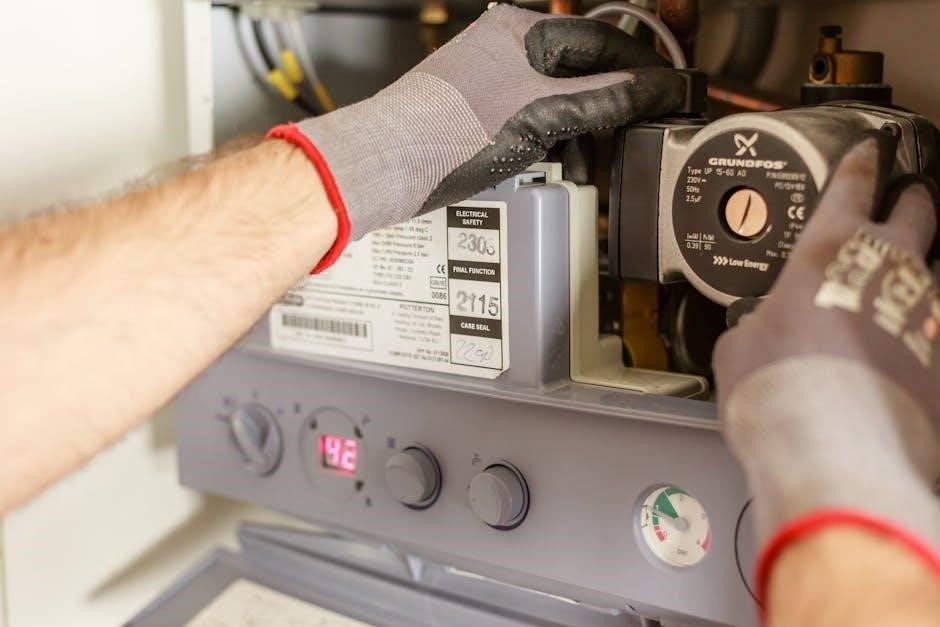
In case of a gas heater emergency‚ such as a suspected carbon monoxide leak‚ strong gas odor‚ or improper ventilation‚ act immediately. Turn off the heater‚ open windows for ventilation‚ and evacuate the premises. Do not attempt repairs yourself‚ as this could worsen the situation. Contact emergency services or a certified technician right away. Carbon monoxide poisoning symptoms‚ like dizziness or nausea‚ require urgent medical attention. Always prioritize safety and avoid risking further damage or health hazards. Professional intervention is crucial in such scenarios to ensure your system is repaired safely and efficiently.
